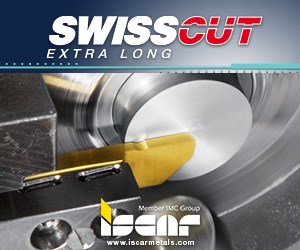Toothed Edge Extends Button Insert Advantages
Particularly for long reach applications, a button insert with a serrated edge can provide greater stability, less heat-generating friction and better chip evacuation than one without.
This footage from Ingersoll Cutting Tools provides a look at the Formmaster R in action.
Although round cutting inserts have a well-deserved reputation for efficiently roughing contoured geometry, they sometimes work best when they’re not perfectly round. For applications involving particularly long overhangs and particularly heat-conducive materials, a button insert with a serrated edge can be far more effective than one without.
That’s according to William Fiorenza, die/mold product manager with Ingersoll Cutting Tools, who emphasizes that proper application of serrated inserts requires carefully considering the details of each individual job. Yet, with due diligence and a sufficiently flexible tooling system, users can amplify the advantages that have made button inserts so popular for heavy roughing.
One of the chief advantages of any button insert is high edge strength. In general, button inserts can withstand greater radial pressure than lead-angle tools because a rounded cutting edge spreads cutting forces more evenly, Mr. Fiorenza explains. That makes the inserts useful for deep cutting depths in extended-reach roughing applications, even on lighter duty machines. Whereas a typical rectangular or triangular high-feed insert might max out at 2 mm or so, the entire radius of a button insert (that is, half the insert) can be buried in the right application, he says.
Nonetheless, the farther the tool is from the spindle, the greater the radial pressure, and the less pronounced the advantage. Serrations add stability by increasing the contact area between cutting edge and workpiece, Mr. Fiorenza says. That stability enables machining at greater lengths with more aggressive parameters while reducing the risk of chatter.
Chip evacuation improves as well, he says. Essentially, each individual tooth carves its own section of chip—a chip that’s far smaller than what would emerge from a button insert with a continuous edge. This helps to improve tool life and reduces the need for extra careful monitoring to ensure chips aren’t being recut. In fact, 60 to 100 psi of shop air is typically sufficient to remove chips created by even the largest serrations available on Ingersoll button inserts, he says. Additionally, a serrated edge creates less heat-generating friction at the point of cut than a continuous edge.
These advantages can potentially extend the application range of serrated buttons beyond long overhangs and heavy roughing. For instance, easier chip evacuation might make them a good alternative even for short-reach applications (although Mr. Fiorenza points out that serrations provide similar benefits for rectangular and square inserts as well). The reduced heat that comes with a serrated insert can also be useful for titanium and high-temperature alloys.
Although a toothed geometry offers plenty of advantages, Mr. Fiorenza emphasizes that there are tradeoffs involved, too. In general, the greater the degree of serration, the weaker the edge, and the lower the chipload it can handle. Thus, applications involving less-than-ideal stock entry, stacked material, interrupted cuts and other abusive conditions should be approached with care, he says. Serrated geometries can also be less economical than their straight-edged cousins because the teeth of each individual insert must properly overlap as the tool rotates. Arranging inserts in this way limits the number of possible indexes compared to a standard round design.
For its part, Ingersoll aims to provide all the options manufacturers need while also minimizing complexity and tool change-over time, Mr. Fiorenza says. Both the FormMaster R and the FormMaster Pro end mills accommodate button inserts with varying degrees of serration as well as straight-edged varieties, so users can swap inserts as needed without changing the entire tool. For the FormMaster Pro, serrated inserts offer four indexes per edge, while straight-edged varieties offer eight. However, the FormMaster R’s inserts are double-sided, thus providing eight total indexes for a serrated insert and 16 for a standard round one. Another difference between the two tools is axial rake angle. The FormMaster R sits negative axial for added strength, which can help compensate for the limits of serrated geometry in abusive cutting conditions. The FormMaster Pro features positive axial rake for freer cutting, which is particularly useful for high-temperature alloys and extreme length-to-diameter ratios.
Whatever the tool and insert combination, Mr. Fiorenza says users should carefully evaluate the intricacies of the application and the capabilities of surrounding technology (the machine, the software, etc.) to determine the right balance between roughing efficiency and tool life. “As is the case with any cutter, you can’t rely solely on the parameter guidelines published in marketing material,” he says. “You have to invest some time to get it right.”
Related Content
All-Around Mill Improves Productivity and Cost for Valve Job
Adopting a mill with a double-negative rake and pockets compatible with multiple insert geometries enabled Progressive Metal Service to increase feed and lower scrap rates for a valve.
Read MoreNew Machining Technology Works With Old to Restore WWII Submarine
A set of donated boring bars that can be used in a 1954 boring head will enable volunteer machinists to recreate a pair of binoculars for the USS Pampanito.
Read MoreBuying a Lathe: The Basics
Lathes represent some of the oldest machining technology, but it’s still helpful to remember the basics when considering the purchase of a new turning machine.
Read MoreBest Practices: Machining Difficult Materials
Cutting hardened steel, titanium and other difficult materials requires picking the right tools, eliminating spindle runout and relying on best practices to achieve tight part tolerances.
Read MoreRead Next
The Cut Scene: The Finer Details of Large-Format Machining
Small details and features can have an outsized impact on large parts, such as Barbco’s collapsible utility drill head.
Read More3 Mistakes That Cause CNC Programs to Fail
Despite enhancements to manufacturing technology, there are still issues today that can cause programs to fail. These failures can cause lost time, scrapped parts, damaged machines and even injured operators.
Read More.png;maxWidth=970;quality=90)











.png;maxWidth=300;quality=90)














